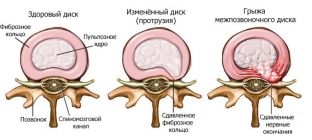Sitting position, constant physical activity, or lack of necessary movement in the lumbar region leads to the possible appearance of a vertebral hernia, which causes a lot of pain, can lead to complete immobilization in case of untimely seeking medical help. And it can also warm up an already painful sensation of a draft or a cold.
The main symptom of a vertebral hernia is acute or aching pain, numbness of the extremities, and as a result, the appearance of headache and dizziness. The problem of how to get rid of an intervertebral hernia is solved in several ways, the main thing is to determine the type and characteristics of the disease in time.
Let's define what is an intervertebral hernia
Imagine an intervertebral disc that contains a pulpous jelly-like nucleus between the vertebrae surrounded by an annulus fibrosus. A spinal hernia is a prolapse or rupture of the annulus fibrosus, and leakage of the nucleus into the outer layer, which leads to compression of the nerve endings. Surgery to treat a hernia is not always the best option. To determine the treatment regimen and the method of getting rid of unbearable pain, a comprehensive examination should be carried out, which should initially contain the findings of an MRI and show how to get rid of an intervertebral hernia.
Types of intervertebral hernias, what are dangerous
There are three main types of hernia of the spine, differ in the nature of the destruction of the fibrous ring and the size of the violations:
- prolapse – the annulus fibrosus deforms and the hernia begins to bulge 2 or 3 mm;
- protrusion is characterized by protrusion of the ring from 5 mm to 15 mm;
- extrusion is characterized by rupture of the annulus and prolapse of the nucleus pulposus to the outside.
According to the location and area of distribution, the hernia can be:
- posterolateral or anterolateral;
- lateral;
- median
- and combined.
Cervical and lumbar regions are considered common sites for hernia.

Symptoms of a herniated disc
Symptoms may vary depending on where the disease occurs. Therefore, consider the main manifestations for each department. The main manifestations of a hernia of the lumbar:
- local manifestation of pain in the area of the affected disc;
- pain radiates to the buttock or leg, tingling or even numbness of the limb;
- weakness and loss of sensation in the limbs;
- problems with the genitourinary system.
Possible manifestations for cervical hernia:
- pain that radiates to the arm, shoulder;
- blood pressure rises and falls sharply;
- dizziness;
- numbness of hands, fingers.
Which treatment technology is the most effective
If the doctor decides that surgery is not required, and it is better to use non-surgical conservative methods, then such methods are aimed at achieving the following goals: eliminate pain, prevent the following possible manifestations of pain, restore limb activity; help the body to establish normal blood circulation and functioning of the whole body. The first thing that is important to do during treatment is not to think about how to get rid of an intervertebral hernia, — this is bed rest, which provides for small loads on the back and neck, alternating with complete rest.
Effective methods that inform how to get rid of a herniated disc without surgery can be:
- Medications: non-steroidal painkillers, analgesics, muscle relaxants, taking cortisone (hormonal drug). Basically, all drugs are aimed at removing pain in the spine. If the pain does not go away after taking medication, the doctor prescribes a blockade of the spine. Together with the blockade, groups of vitamins are prescribed to maintain the functioning of the body and increase the process of tissue regeneration. It is necessary to take the following groups of vitamins: group B, also A, E, C, without fail vitamin D along with calcium, to restore bone structure.
- Ultrasound therapy helps to eliminate pain, tissue regenerates faster and gains elasticity.
- Spine stretching acts not only on the affected disc, but on the entire spine. Such therapy increases the distance between the vertebrae and thus the pressure of the hernia on the disc is reduced, and the nerve endings are released and begin to work properly.
- Exercise therapy is usually prescribed by a doctor as an addition to the main methods of treatment. Specially designed exercises will help increase the resistance of the spine to the load, even just when walking, the muscles will gradually acquire elasticity and firmness.
- To unload the spine from stress, wearing a corset or bandage is prescribed.
Since it is extremely difficult to achieve a full cure for a herniated disc, it is recommended that you constantly see a doctor and follow all the instructions, lead an active lifestyle and exclude physical activity.






Add a comment